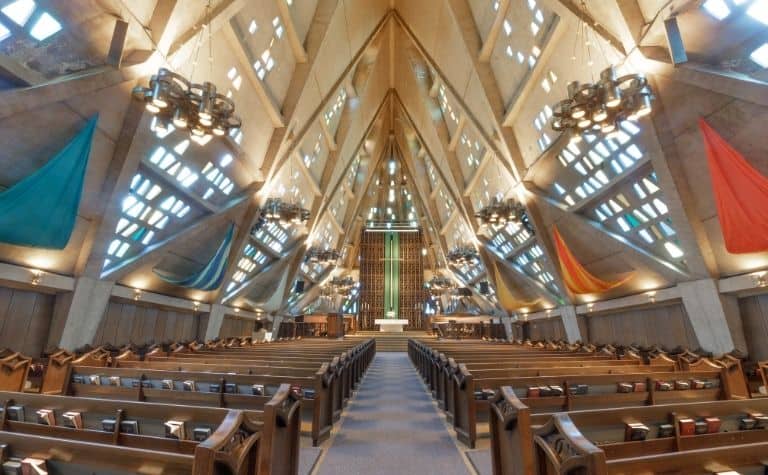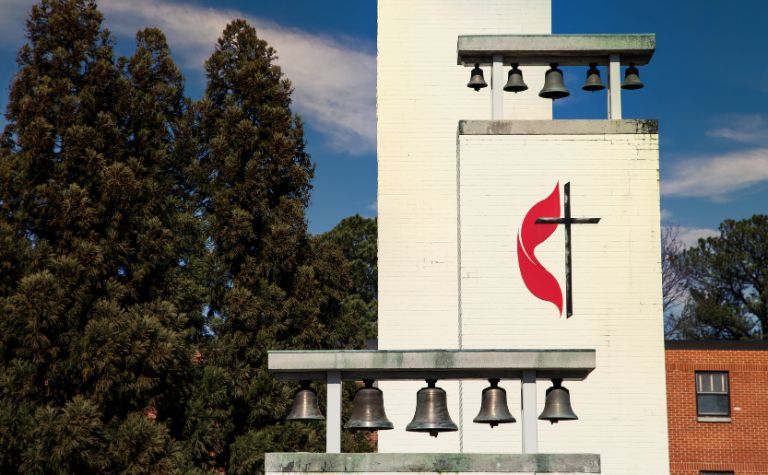Methodism and Anglicanism are distinct branches of Christianity, though they have a closer relationship to each other than to other denominations and traditions. Because of their unique connection, Methodists and Anglicans have a lot in common, but they have significant differences, too.
Anglicanism is a midway point between Catholicism and Protestantism in doctrine and practice, while Methodism is Protestant. The reformation efforts of John Wesley created tension inside the Church of England in the 18th century, which led to a separation between his followers, the Methodists, and the Anglican communion.
What were the disagreements between Wesley and the Anglican church? What is the difference between “Methodist,” “Anglican,” “the Church of England,” and “Episcopalian”? What do Methodists and Anglicans agree on and disagree about today? Keep reading to learn more.
Also see Roman Catholic vs. Protestant vs. Eastern Orthodoxy: Differences to learn more.

When Did Methodists Separate From Anglicans?
John Wesley (1703-1791), the founder of Methodism, never intended to start a new denomination. Instead, he wanted to reform the Church of England through a renewed focus on spiritual disciplines.
He also criticized other aspects of the English church. Anglican leadership resisted Wesley’s efforts and eventually banned him from preaching in their churches. (Also see Methodist vs. Pentecostal: What’s the Difference?)
People called Wesley and his followers “methodists” as a criticism because they disagreed with his allegedly legalistic and rigid approach to Christian living.
Wesley and his followers started using the term to describe themselves in 1729. “A methodist is one who lives according to the method laid down in the Bible,” Wesley said.
Today, the terms “Methodist,” “Anglican,” “Church of England,” and “Episcopal Church” can lead to confusion. While their meanings partially overlap, there are differences between them, as the table below reveals.
| Term | Meaning |
|---|---|
| Methodist denomination | A branch of Protestant Christianity that was started by John Wesley and his brother Charles. Though Methodism is often referred to as a denomination, the tradition includes multiple denominations, the largest of which is the United Methodist Church. |
| Anglican Communion | Often used synonymously with the “Anglican” church, in narrow use, the term describes the Christian church in England itself. |
| Church of England | Often used synonymously with the “Anglican” church, in narrow use, the term describes the Christian church in England itself. |
| Episcopal Church | After the Revolutionary War in America (1775-1783), the Anglican Church adopted the name “Episcopal Church.” From the Greek word for “bishop,” the name refers to the type of church government found in the Anglican tradition, which is bishop-led. |
Did Wesley have success? Yes. Wesley organized pastors and evangelists to travel and proclaim the gospel of Jesus Christ. He sent preachers to places the Church of England had not effectively reached at that time.
Wesley valued the marginalized, the poor, and the outcast. His strategy of using itinerant evangelists to preach the gospel to all people was a profound success. (Also see Methodist vs. Roman Catholic: What’s the Difference?)
Did Wesley have setbacks? Yes. Though he experienced personal and ministry-related setbacks, Wesley and his followers proclaimed the gospel to thousands in England and America.
Though Wesley was known, in part, for his rigid approach to different aspects of the Christian life, he believed that God uses all people, not just the ordained.
He said, “Give me one hundred preachers who fear nothing but sin and desire nothing but God, and I care not whether they be clergymen or laymen; they alone will shake the gates of Hell and set up the kingdom of Heaven upon Earth.”
Something many people wonder about Christianity is, Do All Denominations Go to Heaven? Follow the link to learn the answer to this critical question.

Methodist and Anglican Compared
The first table below provides an overview of Methodism and Anglicanism. The second table compares their beliefs on several doctrines. Readers are encouraged to use this information as a starting point to learn more about each tradition.
| OVERVIEW | Methodism | Anglicanism |
|---|---|---|
| Origin | John Wesley founded Methodism, which arose out of the Church of England in the mid-18th century. | Christianity in England dates to the first few centuries after Christ. However, the Church of England declared independence from the Roman Catholic Church under King Henry VIII (1491-1547) in the Act of Supremacy (1534). |
| Early influencer(s) | Besides John Wesley, Charles Wesley (1707-1788) and George Whitefield (1714-1770) played critical roles in the formation of the denomination. | Thomas Cranmer (1489-1556), King Edward VI (1537-1553), Richard Hooker (1554-1600) |
| Significant writing outside the Bible | The term “connectionalism” describes the network of relationships among Methodist churches. “Bishops” lead churches within the framework of the Episcopalian polity. | The Apostles’ Creed, The Nicene Creed; the Book of Common Prayer (1549); 39 Articles of Religion (1571), which are included in the Book of Common Prayer. |
| Institutional leadership | The “high church” refers to Anglicans who value tradition and wish to conserve the historical teachings of the church. The “low church” refers to Anglicans who believe some traditions and doctrines are outdated and embrace modern social trends that they believe make the church more relevant. | The Archbishop of Canterbury is the head. Synods consisting of lay people, clergy, and bishops, are charged with making significant decisions for the churches in the communion. |
| Divisions | There are many denominations in the Methodist tradition. The United Methodist Church is the largest and has adopted liberal perspectives on many social and theological issues in recent decades. Other small denominations maintain conservative positions.* | The “high church” refers to Anglicans who value tradition and wish to conserve the historic teachings of the church. The “low church” refers to Anglicans who believe some traditions and doctrines are outdated and embrace modern social trends that they believe make the church more relevant. |
*There isn’t a single Methodist denomination. It’s more accurate to speak of the “Methodist tradition,” comprising different denominations. The largest Methodists denominations are,
- The United Methodist Church (UMC): estimated 7.6 million members
- African Methodist Episcopal Church (AMEC): estimated 2.5 million members
- African Methodist Episcopal Zion Church (ECO): estimated 301,000 members
- Christian Methodist Episcopal Church (CMEC): estimated 290,000 members
Also, see What Do Methodists Believe? to learn more.

Methodist vs. Anglican Beliefs
In Methodism and Anglicanism, there are conservative churches and members and liberal ones. Liberal churches and members challenge certain historical teachings of their tradition, embracing ideas consistent with social trends and movements.
Conservative perspectives champion the historic teaching of the church, which is sometimes in contrast with modern values and priorities.
| BELIEFS | Methodism | Anglicanism |
|---|---|---|
| Overview | Methodists are Protestants, believing that salvation is by grace through faith and not according to works. Methodist theology is sometimes called “Wesleyan theology” or “Wesleyan-Arminian theology.” | Some describe Anglicanism as Protestant; others describe it as a middle way between Catholicism and Anglicanism; others describe it as a middle way between Presbyterianism and Lutheranism. The Chicago-Lambeth Quadrilateral is intended to summarize Anglican beliefs.* |
| God | Methodists believe in the Trinity | Anglicans believe in the Trinity |
| Is Jesus God? | Yes | Yes |
| Is the Holy Spirit God? | Yes | Yes |
| The Bible | The Bible is inspired according to traditional Methodist teaching. Some conservative Methodist denominations in America accept and use the term “inerrancy,” which means that Scripture is without error. | The Bible is inspired according to traditional Anglican teaching. |
| Sin | Methodists believe in original sin but not total depravity. | Anglicans believe in original sin but not total depravity. |
| Salvation | Methodists are Arminian, as opposed to Calvinists or Reformed. | Anglicans baptize infants for regeneration, church membership, and the forgiveness of sins. |
| Sanctification | Traditionally, Methodists believe in “Christian perfection” of the heart before death, as opposed to other Protestant denominations that believe that occurs at death for the believer. | Anglicanism doesn’t teach the doctrine of “Christian perfection.” |
| Baptism | Methodists baptize infants as a sign of regeneration. | Methodists believe in the Real presence of Christ, making it more than a memorial like in some Protestant traditions, but they don’t believe in transubstantiation as Catholicism teaches. |
| Communion | Methodists believe in the Real presence of Christ, making it more than a memorial like in some Protestant traditions, but they don’t believe in transubstantiation like Catholicism teaches. | Anglicans reject transubstantiation and the memorial view of the bread and cup. Instead, people receive the elements of the body and blood of Christ through faith. |
| Eschatology | The Second Coming of Christ is a primary doctrine; the millennium is understood according to Amillennial theology. | The Second Coming of Christ is a primary doctrine; the millennium is understood according to Amillennial theology. |
Also see Methodist vs. Lutheran: What’s the Difference?
* The Chicago-Lambeth Quadrilateral describes Anglican theology, worship, and church structure. In addition, the church uses it to summarize Anglican teachings. The quadrilateral is,
- The Holy Scriptures of the Old and New Testaments as “containing all things necessary to salvation” and as being the rule and ultimate standard of faith.
- The Creeds (specifically, the Apostles and Nicene) are sufficient statements of the Christian faith.
- The dominical sacraments of Baptism and Holy Communion.
- The historic episcopate locally adapted.
Please see the related articles below.
References:
[1] Source
[2] Source
[3] Source
[4] Source
Related Articles
The Methodist Church and the Roman Catholic Church both value doctrine and practice. Both traditions also believe they faithfully follow the teachings of Jesus of Nazareth, and they agree on...
Christianity is an important part of the American story in its various denominational expressions. Some denominations came to America from Europe, while others started on American soil. The size of a...
